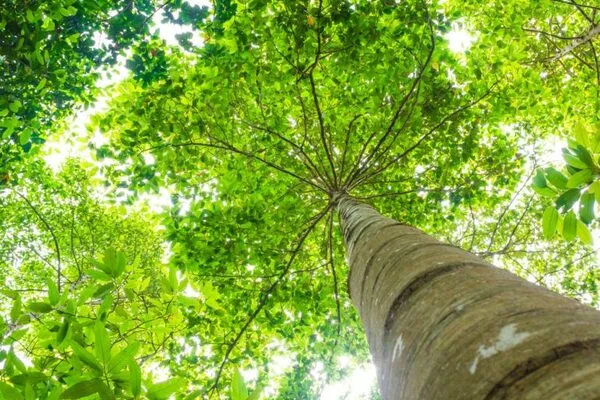A new study paints a vivid picture of how forests evolved over centuries and contribute to the Earth’s carbon balance, which is critical to maintaining a stable global climate. Over 10,000 years, the study reconstructed the natural rate and pattern of carbon storage in forests in the Midwestern United States. The findings have the potential to shift ongoing discussions about how to manage landscapes to maximize carbon storage while meeting conservation objectives.
Plants help the Earth maintain a carbon balance by taking in carbon from the atmosphere and storing it in their leaves, branches, trunks, and roots. This is an important component of maintaining a stable climate.
While woody biomass is one of the largest pools of terrestrial carbon, changes in the magnitude of woody biomass over millennia are poorly understood, with most direct observations of vegetation biomass spanning only a few decades. Because trees grow slowly, this lack of data creates a significant knowledge gap. In the absence of empirical data, scientists make assumptions that lead to uncertainty about the long-term carbon sink and future carbon-climate system projections.
A new study published in the journal Science, seeks to fill this knowledge gap. Led by Ann Raiho of the University of Maryland’s Earth System Science Interdisciplinary Center (ESSIC), an international team of scientists reconstructed the natural pace and pattern of carbon storage, painting a vivid image of how forests developed over centuries. The findings have the potential to shift ongoing debates about how landscapes can be managed to maximize carbon storage while also meeting conservation goals.
We discovered that forest ecology is important for understanding the carbon cycle. Two distinct ecological responses to regionally changing climate drove the steady accumulation of carbon: the spread of forested biomes and the population expansion of high-biomass tree species within forests.
Ann Raiho
“We discovered that forests in the Midwestern United States were expanding and growing larger over the last 10,000 years,” said Raiho, an ESSIC postdoctoral associate. “This demonstrates that the prehistoric baseline for understanding forests was incorrect, and that it is critical for carbon sequestration to preserve trees that grow larger and live longer.”
The researchers created ReFAB (Reconstructing Forest Aboveground Biomass), a Bayesian model that estimates aboveground woody biomass from a time series of fossil pollen assemblages in sediments, for the study. They used ReFAB to statistically reconstruct changes in woody biomass over the last 10,000 years across a 600,000-kilometer area in the Upper Midwest of the United States.
The researchers discovered that after an initial postglacial decline, woody biomass nearly doubled over the last 8,000 years. This result differs significantly from previous reconstructions of forest biomass in eastern Canada, which could be due to forest species differences between regions. Previous studies used simpler models that did not account for data uncertainties and found results that indicated little or no change in biomass over the last 6,000 years. ReFAB corrects these uncertainties by accounting for temporal autocorrelation, uncertainty in sediment-dating, and uncertainty in the relationship between aboveground woody biomass and multivariate pollen data, allowing researchers to zoom in to a finer scale and uncover previously hidden trends.

“We discovered that forest ecology is important for understanding the carbon cycle,” Raiho said. “Two distinct ecological responses to regionally changing climate drove the steady accumulation of carbon: the spread of forested biomes and the population expansion of high-biomass tree species within forests.”
However, the woody biomass that took millennia to accumulate was destroyed in less than two centuries. This carbon accumulation was severely depleted by industrial-era logging and agriculture. The researchers discovered that the decline in woody biomass in the studied region occurred at a rate that was more than ten times faster than the rate of change in aboveground woody biomass in any century over the last 10,000 years.
This discovery could change the way that forests are managed to mitigate the effects of climate change. Storage of biomass in the region was driven by the population expansion of high biomass tree species such as the Eastern Hemlock and American Beech. Once these species were established, high biomass forests were sustained regionally for millennia. This reconstruction confirms arguments that high-biomass species in old forests play important roles in carbon storage and should be preserved.
“Forest management should prioritize the survival of large tree populations,” Raiho said. “This has the potential to mimic natural carbon sequestration processes, extending the timescales and magnitude at which terrestrial ecosystems will continue to buffer climate change by acting as a carbon sink.”
The team will continue this work in collaboration with NASA’s Global Ecosystem Dynamics Investigation (GEDI), which will allow for the protection of large trees by providing high resolution maps of the 3D structure of forests around the world. GEDI will add to our understanding of biomass magnitude, structure, and density. Researchers will be able to better predict the future of forests with this wealth of data.
Raiho and her colleagues intend to use the reconstruction data to improve the simulation models used by the Intergovernmental Panel on Climate Change in order to gain a better understanding of how climate change will affect Earth and its ecosystems. Raiho’s research will improve these simulations and forecasts by informing the models’ vegetation component.
“Without all of the people who collected and counted the fossil pollen data, this work would not be possible,” Raiho said. “Over the last several decades, there were probably a hundred people who did all of the field work. In this study, we used 232 fossil pollen cores. The data collection took thousands of hours. We accessed this valuable data through the Neotoma database.”





